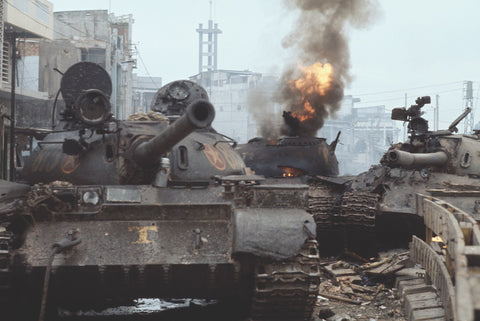
When Communist Forces Turned to Tank Warfare to Seize South Vietnam
After years of wearing down its South Vietnamese and American opponents with a mixture of guerrilla and light infantry tactics, North Vietnam cast them aside for a thoroughly conventional invasion in 1972, with both sides putting an unprecedented emphasis on armored warfare. William E. Hiestand does a comprehensive survey of the equipment, organization, doctrine, and combat practices of the North Vietnamese Army and the South’s Army of the Republic of Vietnam in No. 303 of Osprey’s “New Vanguard” weaponry monographs, Tanks in the Easter Offensive 1972.
Ironically, by 1972 the ARVN armored element had evolved markedly since the early 1960s, when it inherited its armor from the departing French, only to be used more for instruments of political rivalry, with M24 light tanks cynically dubbed “voting machines” and their crewmen “coup troops.”
Well trained and motivated, the ARVN tankers made the most of their M41A3 Walker Bulldog light tanks—essentially enlarged M24s with higher velocity 76mm guns—but worked most effectively with their limited supply of M48A3s, which could outfight the NVA’s T-54s in long-range duels. Although aided by South Vietnamese and American air support that their opponents lacked, the ARVN armored units were handicapped by corrupt senior officers and a fighting doctrine that spread them too thinly over the three fronts on which they had to fight.
this article first appeared in vietnam magazine
Despite their formidable arsenal of Soviet- and Chinese-built T-54s and amphibious PT-76 and Type 63 light tanks, the NVA tankers plunged into the South with a rather inflexible doctrine that often caused them to hesitate when they should have followed up. They also showed that they had much to learn about coordinating their tanks’ operations with their infantry and artillery.
When evaluating the performance of both sides, however, the author rightly reminds the reader that in practice the Easter Offensive was not determined by tanks or armored personnel carriers alone. The campaign saw extensive allied use of the M72 light anti-tank weapon as well as the debut of the TOW (tube- launched, optically tracked, wire-guided) missile.
The NVA soldier, already experienced at using the RPG (rocket-propelled grenade) and recoilless rifle, also made deadly use of newly introduced AT-3 Sagger anti-tank guided missiles. As for the undisputed air power backing the ARVN, the NVA tankers had to rely on a new generation of self-propelled anti-aircraft guns alongside its ubiquitous 12.7 and 14.7mm machine guns.
Profusely illustrated with photographs and profiles, Tanks in the Easter Offensive 1972 offers a fascinating evaluation of two armies adapting their combat doctrines to new-generation weapons, very much as they went along, while the Cold War powers who armed them observed with interest of their own.
Tanks In the Easter Offensive
The Vietnam War's great conventional clash
by William E. Hiestand, Osprey, 2023
If you buy something through our site, we might earn a commission.
